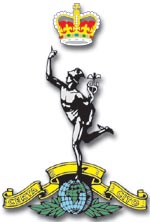18 (UKSF) signals Regiment

Created in 2005, along with the SFSG & SRR, 18 (UKSF) Signals Regiment is one of Britain's newest special forces units. It's remit is to provide signals support to other UKSF elements, such as the SAS and SBS.
Support provided by 18 (UKSF) Signals includes :
- providing secure communications for UKSF operations
- electronic warfare (EW) / signals intelligence (SIGINT) : intercepting and monitoring enemy communications such as mobile phone calls and radio transmissions
The Regiment contains other pre-existing UKSF signals units such as:
- 264 (SAS) Signals Squadron,
attached to 22 SAS - SBS Signals Squadron
attached to the Special Boat Service - 63 (UKSF) Signal Squadron
A reserve unit supporting UKSF
Other sub-units of 18(UKSF) Signals include:
- 267 (SRR) Signals Squadron
attached to the Special Reconnaissance Regiment (SRR) - 268 (SFSG) Signals Squadron
attached to the Special Forces Support Group (SFSG)
A detachment from 14 Signals Regiment provides SIGINT support in the form of Light Electronic Warfare Teams (LEWT).
Men of 18 (UKSF) Signals are highly trained in all aspects of communications. Since they may be expected to accompany UKSF units on operations, they are also trained in various specialised military techniques such as parachuting and escape and evasion.
The Royal Corps of Signals is part of the British Army. For a CD / info-pack full of tips on passing seelction for the British Army, click here.
18 (UKSF) Signals Weapons
Weapons employed by the various 18 (UKSF) Sigs units include:
18 (UKSF) Signals Selection
Selection for 18 (UKSF) Signals is open to all serving members within the UK military with the following qualifications :
- Class 2 in a Signals trade
- To have passed BFPA and All Arms CFT
- To have at least 3 years’ residual service left
- Preferably, to have served 12 months in a working unit.
A 5-day induction proceeds the main selection during which candidates get an idea of what to expect. Main selection comprises of a 24 week Special Forces Communicator (SFC) course, run in March,
April, August, and October, each year.
The Special Forces Communicator (SFC) course comprises:
- Technical Trade Assessment (1 week)
- General Support Comms (6 weeks)
- Physical Aptitude (5 weeks)
- Close Support Comms (5 weeks)
- Conduct After Capture (2 weeks)
- Military Training (3 weeks)
- SF Parachute Training (3 weeks)
18 (UKSF) Signals - Losses
Sadly, several 18 (UKSF) signallers have been lost in recent years
- January 2005 - Iraq
An SAS Signaller (264 (SAS) signals) perished onboard a RAF Special Forces Hercules that was shot down over Iraq. The Hercules was scouting for emergency airstrips from which to extract the contingent of SAS troops it had just dropped off. - September 2, 2006 - Aghanistan
RAF Nimrod spy plane (XV230) caught fire and exploded over Afghanistan, with the loss of all 14 servicemen onboard, which included 2 signallers, one attached to the SBS, (SBS Signals Squadron) and the other to the SFSG (268 (SFSG) Signals Squadron). The Nimrod was supporting Operation Medusa, a major NATO offensive against the Taliban, which included UK Special Forces on the ground.








